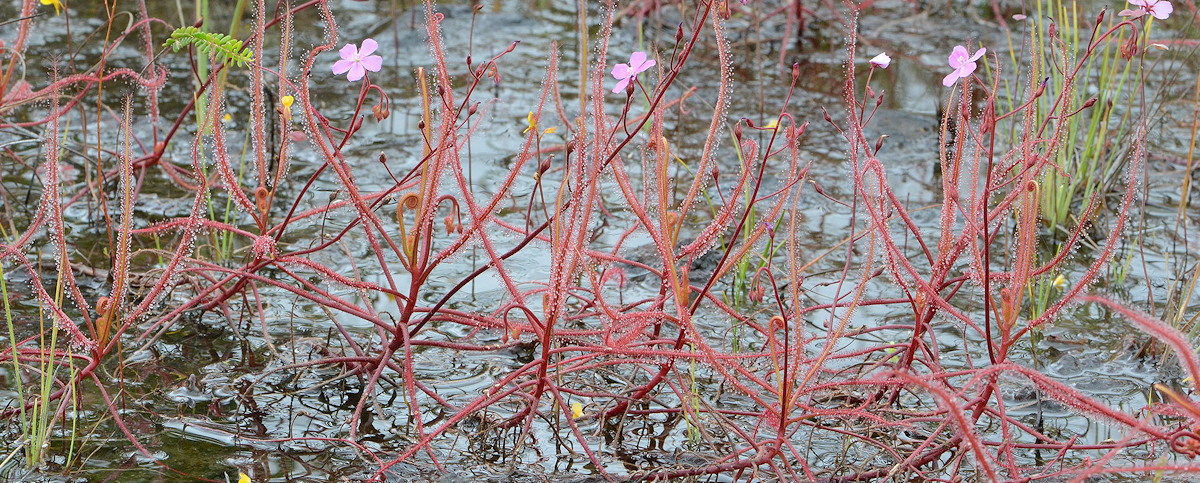
Drosera serpens, Queensland, Australia. Photo © Richard Nunn.
There are at least 11 species in the Drosera indica complex. Eight are endemic to the Kimberley region of Western Australia and the adjacent Northern Territory of Australia. The others are widespread in the old world tropics.
Why in 2013 with the publication of a paper by Russell Barrett and Allen Lowrie and a Magnum Opus by Allen Lowrie do we suddenly have 11 species in the Drosera indica complex instead of two? Part of the reason is the rules of formal taxonomy and that the taxonomists doing the descriptions were working in Europe. It is quite possible the European authors had never seen a live Drosera indica complex plant much less grown one. They sat around all day sorting piles and piles of herbarium specimens, writing down what they observed on the dried, dead plants. Some of these specimens could be over 100 years old and in very bad shape after being shipped half way around the planet. It might be difficult to recognize some of the subtle defining characters on the specimens and, even more important, they could have been confused by two species being present at some locations and thus ending up on the same herbarium sheet.
The species name Drosera indica was formalized in 1753 by Linnaeus based on a drawing of a plant collected in Sri Lanka. The Kew herbarium has a photo of Drosera indica herbarium specimens from Sri Lanka, peninsular India, and Myanmar (Burma) on one page. Specimens K000659128 from Sri Lanka are the plants at the top left.
The name Drosera finlaysoniana was initially attached to an herbarium specimen from Vietnam without a description by Wallich (1828, #3752). The name was formalized and minimally described later by Arnott (1836). The Wallich herbarium sheets are now at Kew; the upper specimen in K000217501 is Drosera finlaysoniana but the lower specimen may be a different species.
Drosera serpens was defined by Planchon (1848) based on an herbarium specimen from Northern Territory, Australia. Planchon also included an expanded description of Drosera indica but he said the specimens of Drosera finlaysoniana he had seen were in such poor condition he could not properly describe them. The Muséum national d’Histoire naturelle, Paris, has an herbarium specimen (P04963021) that is most likely Drosera serpens based on the location.
Additional names have been applied to specimens representative of this species complex: Drosera angustifolia (F. Mueller 1855), Drosera hexaginia (Blanco 1845), Drosera makinoi (Masamune, 1935), Drosera metziana (Gandoger 1913), and Drosera minor (Schumacher 1827). (See Schlauer (CP Names Database), International Plant Names Index, and Lowrie (2013)). These names appear to be synonyms of previously named species. However at some point any of them could be resurrected in a revision of Drosera indica itself.
The number of recognized species in the Drosera indica complex was reduced to one when Diels published his major monograph on the Droseraceae in 1906. He organized and described the Drosera species then known as well as drawing representatives of each group.
Diels decided, based on the herbarium material available to himself, to lump everything remotely like Drosera indica under that name. He did not say why he lumped the species other than he considered Drosera indica to be very variable: it could be robust or not; it can have petioles 5-10 mm long or none at all. The drawing he published is of a plant that looks like Drosera finlaysoniana (no petiole) but the seed he drew looks most like Drosera indica but could also be Drosera finlaysoniana (see seed images in Lowrie 2013).
This all changed when Allen Lowrie got on the case. Lowrie (2013) describes the 10 Drosera indica complex species found in Australia in very fine detail resurrecting the names Drosera finlaysoniana and Drosera serpens and applying new names to previously undescribed species. Many of the details used to determine the species may only be easy to discern in live material or you would have to see them in live material to recognize them on a dead, pressed and dried plant.
Unfortunately a description of Drosera indica itself was beyond the scope of Lowrie's Magnum Opus. As of now, anything that does not fit any of the other species is still lumped into a still very variable Drosera indica. It may take someone else's magnum opus to make full sense of this enigmatic species complex.
— John Brittnacher
October 2014
For information please see:
Arnott, G. A. W. (1836). Synopsis of the East Indian species of Drosera and Parnassia. In: Hooker, W.J. (ed.) Companion to the Botanical Magazine. Vol. 2. pp. 313–315. E. Conchman for S. Curtis, London. (Read online)
Barrett, R. L. and A. Lowrie (2013) Typification and application of names in Drosera section Arachnopus (Droseraceae). Nuytsia 23:527–541.
Blanco, Manuel. (1845) Flora de Filipinas segun el sistema sexual de Linneo 2. M. Sanchez, Manila. (Read online)
Diels, F. L. E. (1906) Droseraceae. In: Engler, H.G.A. (ed.) Das Pflanzenreich, vol. 4. pp. 1–136. Engelmann, Leipzig. (Read online)
Gandoger, J.M. (1913) L’herbier Africain de Sonder. Bulletin de la Société Botanique de France 60:414–422, 455–462. (Read online)
Linnaeus, C. (1753) Species plantarum. Impensis Laurentii Salvii, Stockholm.
Lowrie, A. (2013) Carnivorous Plants of Australia Magnum Opus. 3 Volumes. Redfern Natural History Productions, Poole, GB.
Masamune, G. (1935) Beitrage zur Kenntnis der Flora von Südjapan (IV). Transactions of the Natural History Society of Formosa 25(136):11-16.
(Some authors list G. Masamune (1932. Taiwan plant Miscellany I. Transactions of the Natural History Society of Formosa 22:195) as the description for Drosera makinoi because that is what is referenced in Michio Tamura (1953. Key to the Insectivorous Plants of Japan [in Japanese]. Acta phytotaxonomica et geobotanica 15(1):31-32). The Flora of Taiwan, 1st edition 2:649 lists the 1935 paper as the type description so it is used here. The description in the Flora of Taiwan does not list the type plant as having petioles, the drawing on page 648 is of Drosera finlaysoniana as are the plants in an herbarium specimen (Flora of Taiwan F00002449) from the type location of Drosera makinoi in Taiwan.)
Mueller, F .J. H. (1855) Australian plants. Art. II. Definitions of rare or hitherto undescribed Australian plants, chiefly collected within the boundaries of the Colony of Victoria and examined by Dr. Ferd. Mueller. Transactions of the Philosophical Society of Victoria 1:5–24. (Read online)
Planchon, J.-É. (1848) Sur la famille des Droséracées. Revisio systematica Droseracearum. Annales des Sciences Naturelles, Botanique séries 3, 9:185–207,285-309. (Read online)
Schlauer, Jan. (2001) Drosera hartmeyorum spec. nov. (Droseraceae), a new sundew in sect. Arachnopus from Northern Australia. Carniv. Pl. Newslett. 30(4):104-106. ( PDF )
Schumacher, C .F. (1827). Beskrivelse af Guineiske planter: som ere fundne af Danske botanikere, især af etatsraad Thonning. F. Popp, Kjöbenhavn. (Read online)
(Diels (1906) lists the reference to Drosera minor being on page 187 but it is on page 167.)
Wallich, N. (1828) Numerical list of dried specimens of plants in the Museum of the Honl. East India Company which have been supplied by Dr. Wallich, superintendent of the botanic garden at Calcutta. East India Company, London. (Read online, specimen 3752) (the herbarium specimen at Kew)

The type of Drosera indica, part of the the Paul Hermann Herbarium from the 1670s. Linnaeus used this drawing to define Drosera indica.
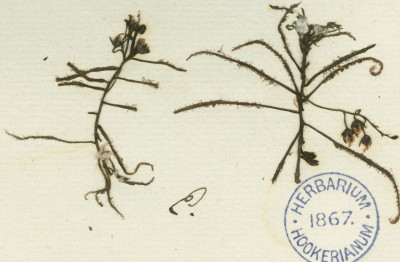
Detail of K000659128 showing Drosera indica from Kalutara, Sri Lanka, collected by James Macrae, likely 1827-1830 (bio). Notice these specimens have petioles while the Paul Hermann drawing above has the trapping tentacles all the way to the base of the leaves. Image © Board of Trustees of the Royal Botanic Gardens, Kew.
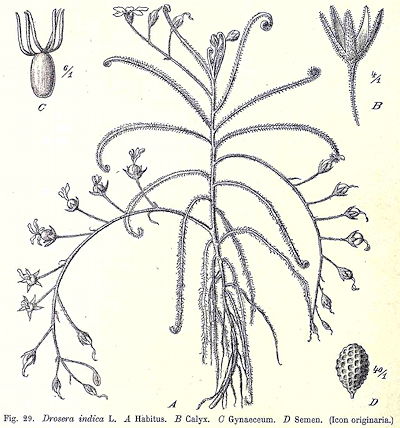
Diels (1906) drawing of "Drosera indica". Image reproduced from the Digital Library of the Royal Botanical Garden of Madrid (CSIC), Droseraceae p. 78.

Drosera finlaysoniana pressed and dried on an herbarium sheet. It is specimen HO30798 at the Tasmanian Herbarium, University of Tasmania. The collection location is reported to be near Mcarther, Northern Territory, Australia. Photo © Robert Gibson.
Distinctive characters of the species of the Drosera indica complex.
| Species† First Description |
Petiole | Glands and other appendages other than typical for Drosera | Flowers |
|
D. aquatica |
none | Stem covered with tiny translucent white glandular trichomes and long translucent white pilose hair. | Petals pink |
| D. aurantiaca Lowrie (2013) |
none | Stem covered with tiny translucent white glands. | Petals orange. |
| D. barrettorum Lowrie (2013) |
none | Stem covered with short, translucent white glands. Non-glandular red trichomes with beige potato-crisp(chip)-like apexes on leaf top near stem. | Petals lavender. |
| D. cucullata Lowrie (2013) |
10-14 mm | Stem and petiole covered with short white glands and shorter white, non-glandular trichomes. Petiole also with red non-glandular clavate trichomes. | Petals white or pink. Stamens blood red, deltoid,curved, hooded. |
| D. finlaysoniana Arnott (1836) |
none | Stem covered with tiny translucent white, glandular trichomes. | Petals white or pink. |
| D. fragrans Lowrie (2013) |
12-18 mm | Stem densely covered with tiny translucent white, non-glandular trichomes and and a few longer glands. T-shaped non-glandular appendages on petiole. |
Petals cerise. |
| D. glabriscapa Lowrie (2013) |
1.5-2 mm | Stem moderately covered with tiny translucent yellow, non-glandular, conical trichomes. Yellow translucent non-glandular conical trichomes on whole plant except scape. Scape glabrous. | Petals red. Stamens, stigmas, styles blood red. Stamens deltoid. |
| D. hartmeyerorum Schlauer (2001) |
none | Stem covered with tiny translucent white, glandular trichomes. Non-glandular red trichomes with yellow blackberry-like apexes on base of leaves. | Petals redish. |
| D. indica* Linnaeus (1753) |
5-10 mm | Stem and petiole covered with tiny translucent white or red, glandular trichomes and Asian forms may have scattered larger translucent red glands. Filiform stipules may be present. |
Petals pink, mauve or |
| D. nana Lowrie (2013) |
1-1.5 mm | Stem and petiole with scattered, rigid, non-glandular trichomes with a few slightly longer trichomes. | Petals white to pink. |
| D. serpens Planchon (1848) |
10-12 mm |
Stem and petiole with tiny non-glandular, translucent white trichomes and scattered translucent white glands. The stem also has scattered larger translucent red glands and a number of larger translucent red trichomes bearing large, shiny, yellow, non-glandular mushroom-like heads in the style of a bowler hat. The petiole also has Y-shaped non-glandular appendages. |
Petals white or pink. Stamens white, triangular. |
| Species† | Range | Seeds | Notes |
| D. aquatica | Near Kununurra, Kimberley region, WA, and near Darwin, NT, Australia. | Ovoid, 0.42-0.45 mm long. |
Affixed aquatic or free floating. |
| D. aurantiaca | From near the Prince Regent River to near the Drysdale River, Kimberley region, WA, Australia. |
Ellipsoidal, 0.37- |
Plants redish. |
| D. barrettorum | From near the Prince Regent River to near the Drysdale River, Kimberley region, WA, Australia. | Ovoid, 0.31-0.35 mm long. |
Stem green turning redish, leaves |
| D. cucullata | From near the Prince Regent River to near Wyndham, Kimberley region, WA, Australia. | Oblong, 0.86-0.90 mm long. |
Plant dull green turning redish. |
| D. finlaysoniana | Widespread across central Australia, Vietnam, Laos, Taiwan and China. | Ellipsoidal, 0.50- 0.55 mm long. |
Common in drier locations that may flood seasonally. |
| D. fragrans | From Broome, Kimberley region, WA, to around Darwin, NT, Australia. | Broadly ovoid, 0.50- 0.55 mm long. |
Plants emit a very strong honeydew melon-like scent, possibly from unique appendages as leaf bases. |
| D. glabriscapa |
Near Beverley Springs Station and near Theda Station, Kimberley region, WA. |
Ovoid, 0.30-0.35 mm long. |
Plant green turning redish. |
| D. hartmeyerorum | From Broome, Kimberley region, WA, to near the Keep River, NT, Australia. | Ovoid, 0.34-0.35 mm long. |
Stem red. Leaves green to reddish. |
| D. indica* | Widespread across west to southeast Africa, Madagascar, India, and southeast Asia to China and Japan. | Ovoid, 0.4-0.5 mm | Plants red or green. |
| D. nana | Near Darwin, NT, Australia. | Ellipsoidal, 0.31- 0.33 mm long. |
Plants short: 7-10 cm tall. |
| D. serpens | Widespread across northern and northwestern Australia, southeast Asia including China, Vietnam, and Philippines. | Ovoid, 0.50-0.55 mm long. |
Plants red or green. |
† Information on all species except Drosera indica is from Lowrie (2013). Some of the information was also published in Barrett and Lowrie (2013).
* It is unclear at this point exactly what constitutes Drosera indica. There are additional forms that may warrant species status. The description of Drosera indica here is based on statements in Lowrie (2013) and photos and descriptions by J. R. Laudon (1978) Flora Zambesiaca, Vol 4 Part 0, page 62, Royal Botanic Gardens, Kew, Flora of West Tropical Africa, Vol 1 Part 1, Flora of Zimbabwe, Flora of Mozambique, Flora of China, and unpublished photos.
Close-up photos of plant details.
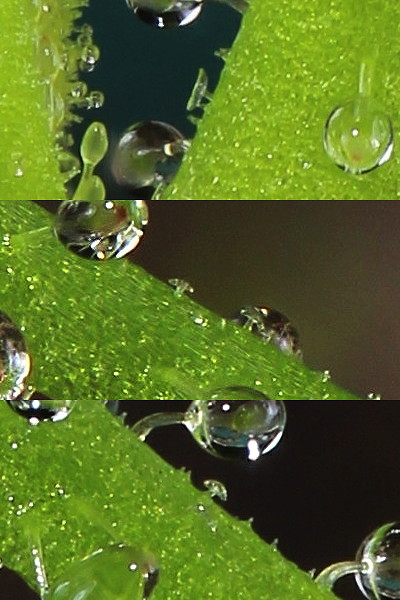
T-shaped trichomes near leaf bases of Drosera finlaysoniana. These are not the same as the larger, opaque T-shaped trichomes reported on Drosera fragrans but are probably homologous structures. The digestive tentacles provide scale.
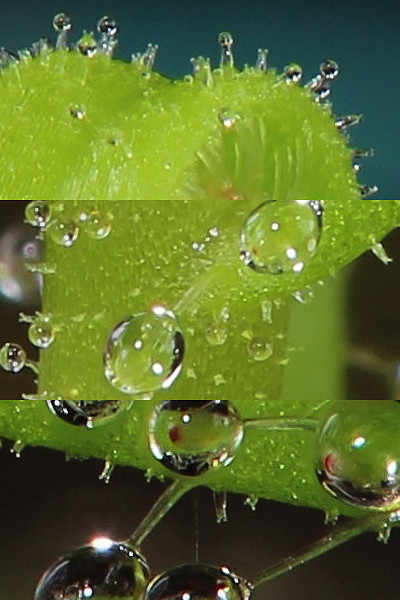
Glandular and non-glandular trichomes on unspiraling leaf, stem and leaf base, and mature leaf of Drosera finlaysoniana. The digestive tentacles provide scale.

Drosera indica, Phu Phan National Park, Thailand. Notice the stipules (long hairs at base of leaves). Photo © Forbes Conrad.
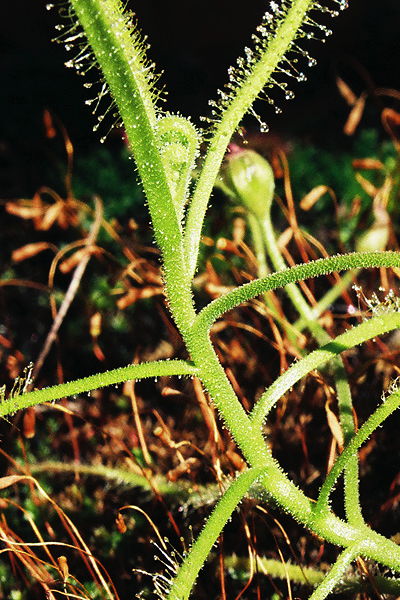
Drosera indica, Republic of South Africa. Notice the denser glandular hairs compared to the Asian form. Photo © Robert Gibson.

Drosera finlaysoniana, Narrabri, New South Wales, Australia. Photo © Robert Gibson.
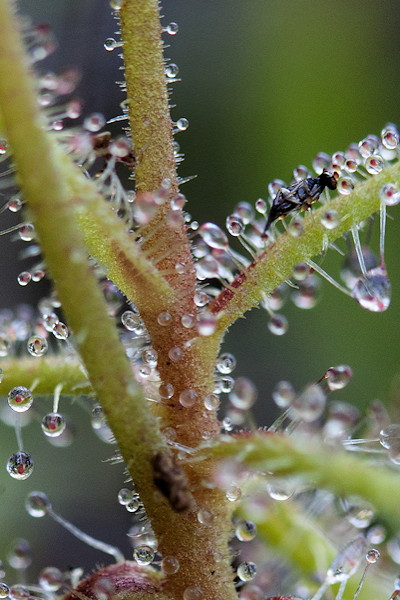
Drosera nana, Darwin area, Northern Territory, Australia. Photo © Greg Bourke.

Drosera hartmeyerorum, Kimberley Region, Western Australia. Notice the yellow blackberry-like appendages that reflect light (see video Drosera Snap Trap Tentacles and Runway Lights by Siggi Hartmeyer). Photo © Greg Bourke.
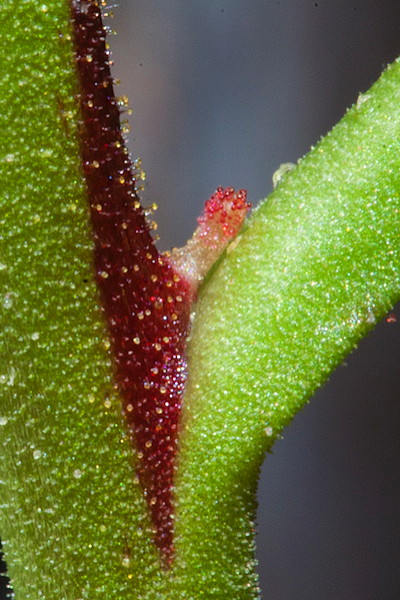
Drosera fragrans, Kimberley Region, Western Australia. Notice the appendage at the leaf base that is believed to be giving off the fragrance and the T-shaped appendages on the petiole of the leaf. Photo © Greg Bourke.

Drosera aquatica, Darwin area, Northern Territory, Australia. Photo © Richard Nunn.
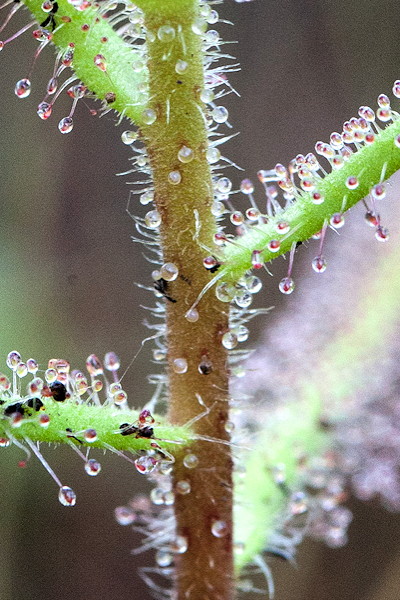
Drosera aquatica, Darwin area, Northern Territory, Australia. Photo © Greg Bourke.
Photos of plants in the Drosera indica complex.
Plants in natural habitat.
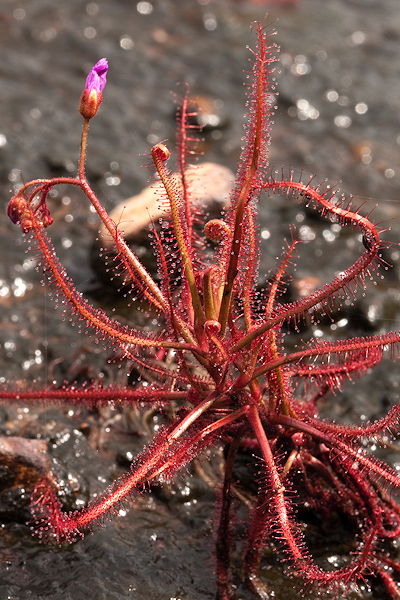
Drosera indica, Phu Phan National Park, Thailand. Photo © Forbes Conrad.
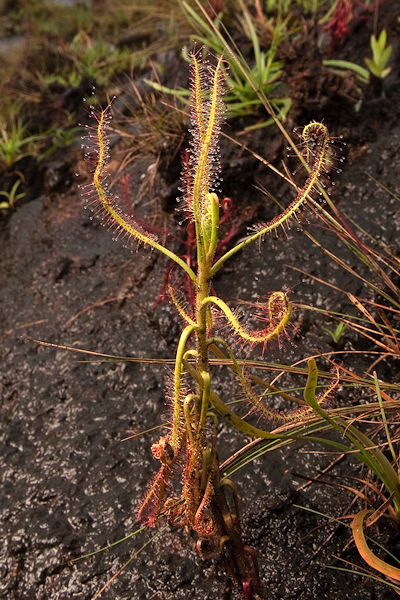
Drosera indica, Phu Phan National Park, Thailand. Photo © Forbes Conrad.

Drosera indica, Phu Phan National Park, Thailand. Photo © Forbes Conrad.
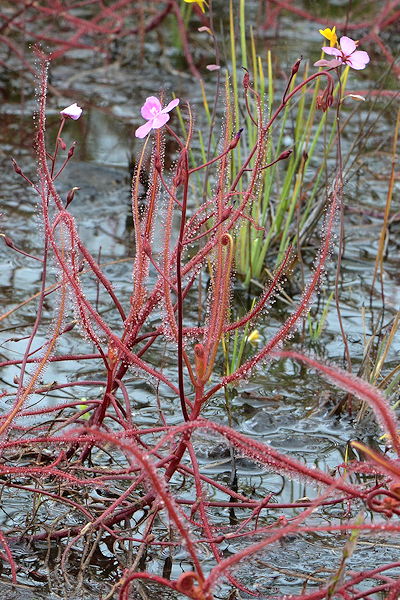
Drosera serpens, Queensland, Australia. Photo © Richard Nunn.
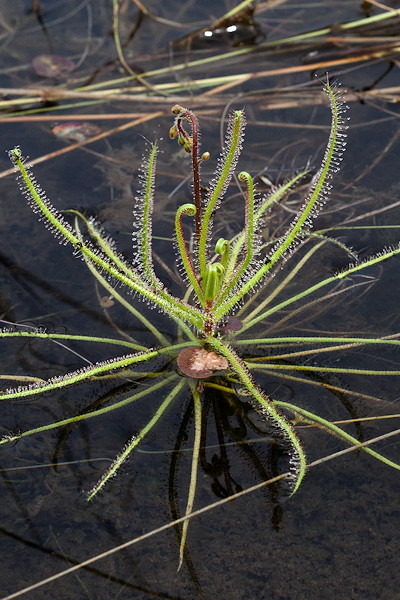
Drosera aquatica, Darwin area, Northern Territory, Australia. Photo © Greg Bourke.
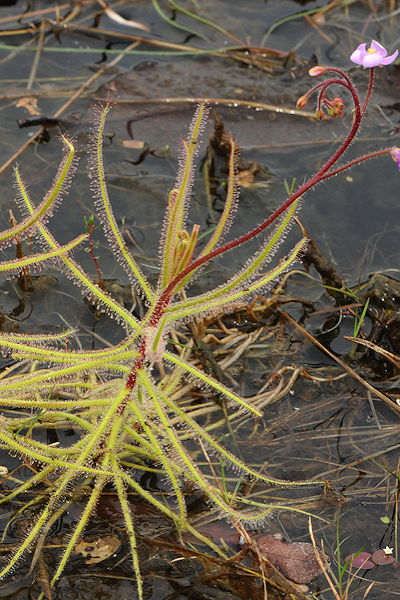
Drosera aquatica, Darwin area, Northern Territory, Australia. Photo © Richard Nunn.
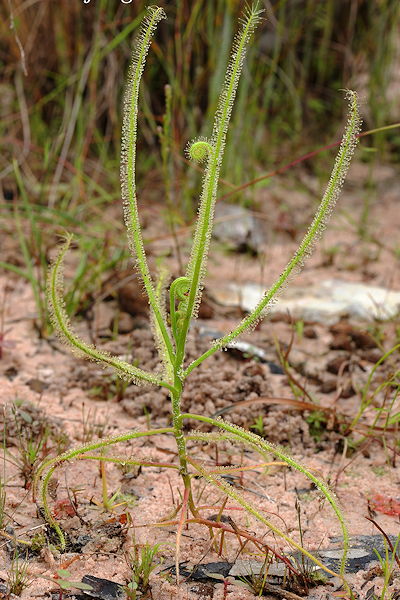
Drosera fragrans, Darwin area, Northern Territory, Australia. Photo © Richard Nunn.
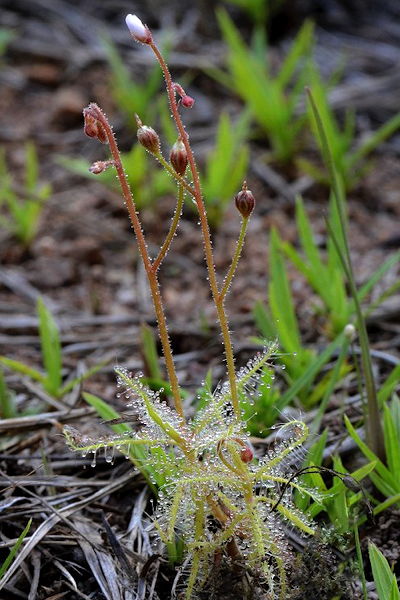
Drosera nana, Darwin area, Northern Territory, Australia. Photo © Richard Nunn.
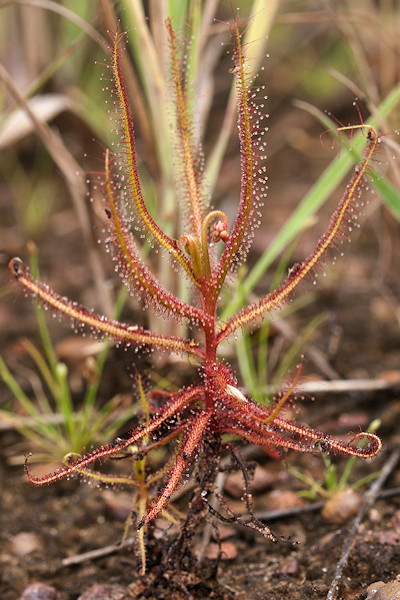
Drosera hartmeyerorum, Kimberley Region, Western Australia. Photo © Greg Bourke.
Close-up photos of flowers. As well as petal color, notice the shape and color of the stamens, styles, and stigmas.
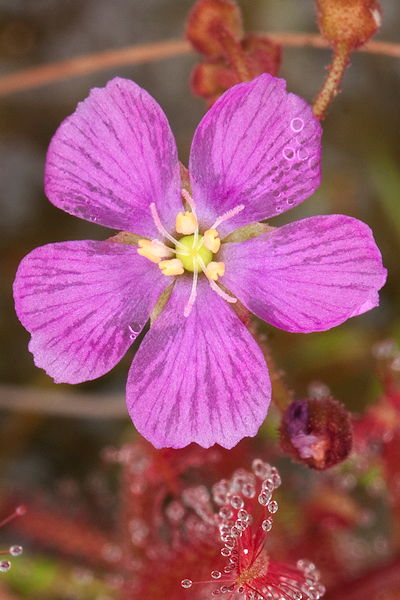
Drosera indica, Phu Phan National Park, Thailand. Notice the stigmas are shorter and not as curved and the stamens not as triangular as the African form. Photo © Forbes Conrad.
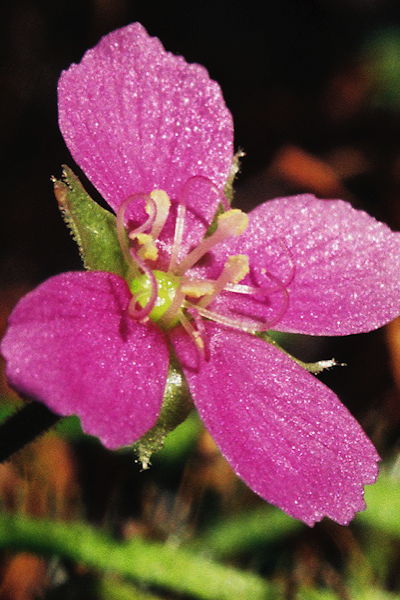
Drosera indica, Republic of South Africa. Notice the stigmas and stamens are similar to Drosera serpens. Photo © Robert Gibson.
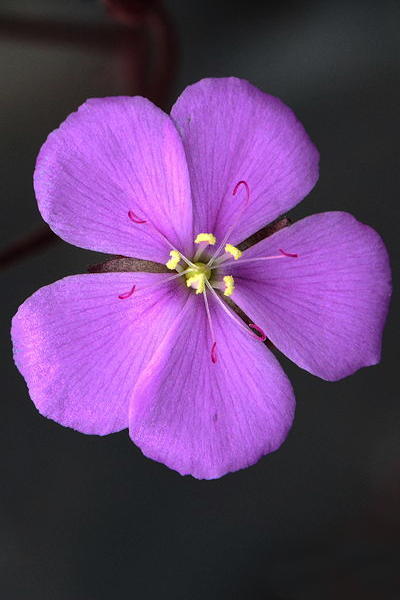
Drosera serpens, Queensland, Australia. Photo © Richard Nunn.

Drosera serpens, Kakadu National Park, Northern Territory, Australia. Photo © Richard Nunn.
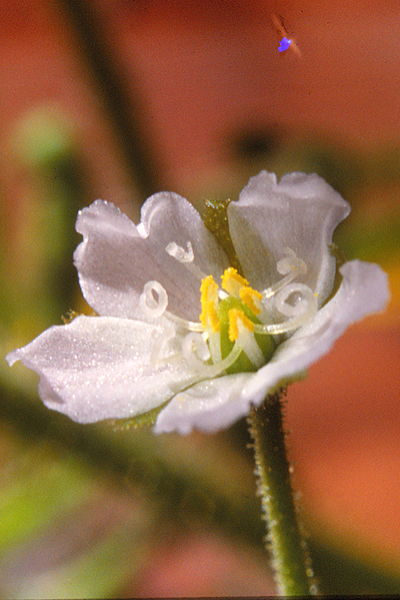
Drosera finlaysoniana, Narrabri, New South Wales, Australia. Photo © Robert Gibson.
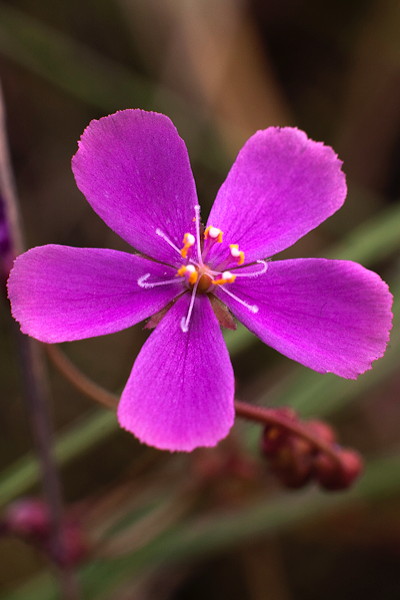
Drosera hartmeyerorum, Kimberley Region, Western Australia. Photo © Greg Bourke.

Drosera aquatica, Darwin area, Northern Territory, Australia. Photo © Richard Nunn.
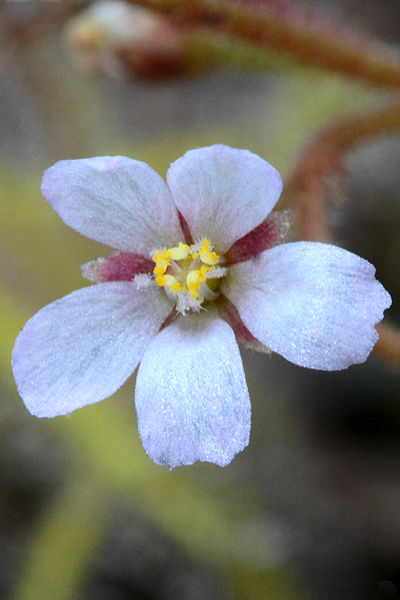
Drosera nana, Darwin area, Northern Territory, Australia. Photo © Richard Nunn.
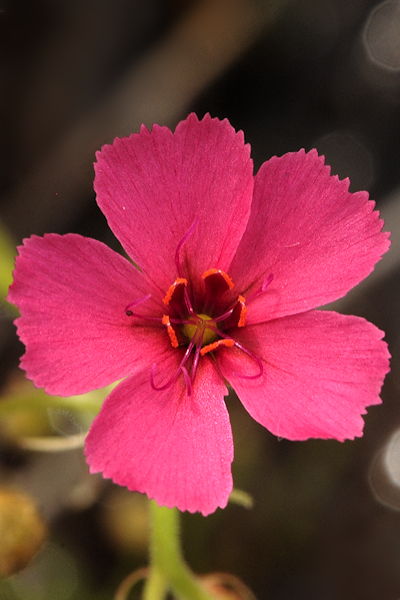
Drosera fragrans, Darwin area, Northern Territory, Australia. Photo © Richard Nunn.
